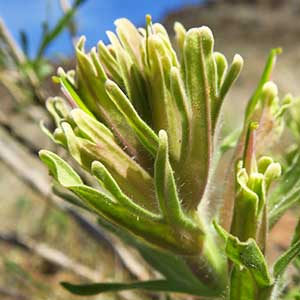Castilleja xanthotricha
Castilleja cusickii
John Day or yellow-hairy paintbrush, John Day paintbrush, yellow hair paintbrush, yellow-hair Indian paintbrush
Cusick's Indian paintbrush, Cusick's paintbrush
few to several, ± decumbent to erect or ascending, unbranched, sometimes with short, leafy axillary shoots, hairs erect to spreading, long, soft, eglandular, mixed with short stipitate-glandular ones.
solitary or few to several, erect, often decumbent at base, unbranched, sometimes branched, hairs spreading, long, soft, eglandular, mixed with shorter, sometimes stiff, stipitate-glandular ones.
green, linear, lanceolate to broadly lanceolate, oblong, or cuneate, 0.8–5 cm, not fleshy, margins plane to wavy, involute, 0–5-lobed, apex acute, sometimes rounded;
lobes spreading, linear, arising below mid length, nearly as broad as center lobe, apex acute.
green, sometimes with prominent red-purple veins, lanceolate-linear to broadly lanceolate, 2.5–4.5(–7) cm, not fleshy, margins plane, flat, (0–)3–5(–9)-lobed, apex acuminate to acute;
lobes spreading-ascending, narrowly lanceolate, arising at or above mid length, apex acute.
3–14 × 1.5–4.5 cm;
bracts proximally greenish, rarely dull reddish purple, distally white to cream, rarely pale yellow or dull, pale pink (sharply differentiated from proximal coloration), lanceolate or oblong to narrowly ovate, (3–)5–7-lobed;
lobes ascending, linear to obovate, ± broadened distally, medium, long, proximal lobes arising below mid length, central lobe apex broadly rounded to truncate, others acute to rounded.
3.5–26 × 1.5–3.5 cm;
bracts pale green, pale greenish yellow, or pale yellow throughout, or proximally pale green, pale greenish yellow, pale yellow, or reddish purple, distally white, yellow, pink, dull purple, or dull reddish purple, sometimes with a purple band below that, sometimes with veins darker than background color, lanceolate to oblong, 0–5(–9)-lobed;
lobes ascending or spreading, linear to narrowly lanceolate, often short, arising above mid length, central lobe apex rounded, lateral ones acute to rounded.
curved, 17–23 mm;
tube 15–19 mm;
beak exserted, adaxially green, 5–8(–9) mm, puberulent, stipitate-glandular;
abaxial lip deep purple (color sometimes visible through calyx), green, pinkish, or pale yellow, ± prominent, slightly inflated, usually hidden in calyx, sometimes right at top of calyx, 2 mm, ca. 50% as long as beak;
teeth ascending, whitish, yellowish, pink, or green, 1–1.5 mm.
straight, 19–25(–28) mm;
tube (13–)15–20 mm;
abaxial lip included, beak not or slightly exserted;
beak adaxially green to yellow-green, 4–7 mm;
abaxial lip yellow, prominent, inflated, 2–4.5 mm, ca. 75% as long as beak;
teeth incurved to erect, white, 1.3–2.1 mm.
colored as bracts, 15–26 mm;
abaxial and adaxial clefts 3.5–7 mm, 25–50% of calyx length, deeper than laterals, lateral 2–5 mm, 12–25% of calyx length;
lobes linear, oblong, or narrowly triangular, center lobe apex usually rounded, lobes acute to rounded.
green, pale green, or pale yellow, lobes yellow to pale yellow, 20–30 mm;
abaxial and adaxial clefts 6.6–14 mm, 33–50% of calyx length, deeper than laterals, lateral 0–4(–4.5) mm, 0–15% of calyx length;
lobes broadly rounded to triangular, apex obtuse to rounded.
= 48.
= 24.
Castilleja xanthotricha
Castilleja cusickii
Castilleja xanthotricha is endemic to moderate elevations in the sagebrush hills of the John Day River drainage in north-central Oregon. N. H. Holmgren (1971) hypothesized that this tetraploid species is of allopolyploid hybrid origin between C. glandulifera and C. oresbia.
(Discussion copyrighted by Flora of North America; reprinted with permission.)
Castilleja cusickii includes two morphologically distinct variants. One variant has a wider inflorescence, broader bracts, and wider bract lobes. These bracts often have highly contrasting purple veins, and some populations also have a purplish wash on the bracts. These plants have a range on the western edge of typical C. cusickii, though overlapping with more typical forms in western Idaho and adjacent northeastern Oregon and southeastern Washington. The name C. lutea is available for these variants, and both consistent morphological differences and preliminary results from ongoing genetic research on the plants (D. C. Tank, pers. comm.) indicate its resurrection may be justified. A second variant is distinguished by a pale pink-purple wash on the bracts and a narrow distribution in the meadows of the Bear River Valley, bordering northwestern Utah and adjacent southeastern Idaho. Only bract coloration appears to distinguish this form from typical C. cusickii, and the distinctive bract coloration is only more or less consistent in these populations.
Typical Castilleja cusickii appears to hybridize with C. gracillima in the Logan Valley, Grant County, Oregon. It is also reported by M. Ownbey (1959) to hybridize with C. miniata and C. rhexiifolia.
(Discussion copyrighted by Flora of North America; reprinted with permission.)
